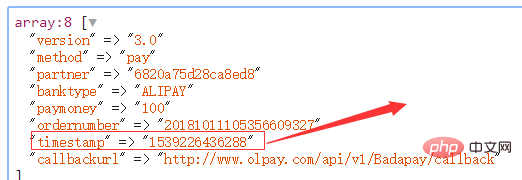
php 获取当前时间戳、日期并精确到毫秒
首先,我们封装一个获取时间戳的方法:
第一种方法:时间戳13位
/**
* 获取时间戳到毫秒
* @return bool|string
*/
public static function getMillisecond(){
list($msec, $sec) = explode(' ', microtime());
$msectime = (float)sprintf('%.0f', (floatval($msec) + floatval($sec)) * 1000);
return $msectimes = substr($msectime,0,13);
}其次,调用这个方法,并打印结果:

看看结果:

成功获取到了,时间戳且精确到了毫秒!---- 13位,自己数数。
第二种方法:时间戳浮点型
/**
* 时间戳 - 精确到毫秒
* @return float
*/
public static function getMillisecond() {
list($t1, $t2) = explode(' ', microtime());
return (float)sprintf('%.0f',(floatval($t1)+floatval($t2))*1000);
}调用:
//时间戳 $_t = self::getMillisecond(); dd($_t);
打印结果:

第三种方法:14位年月日时分秒+3位毫秒数
/**
* 年月日、时分秒 + 3位毫秒数
* @param string $format
* @param null $utimestamp
* @return false|string
*/
public static function ts_time($format = 'u', $utimestamp = null) {
if (is_null($utimestamp)){
$utimestamp = microtime(true);
}
$timestamp = floor($utimestamp);
$milliseconds = round(($utimestamp - $timestamp) * 1000);
return date(preg_replace('`(?<!\\\\)u`', $milliseconds, $format), $timestamp);
}调用:
/**
* @param array $reqData 接口传递的参数
* @param PayMerchant $payConf object PayMerchant类型的对象
* @return array
*/
public static function getAllInfo($reqData, PayMerchant $payConf)
{
/**
* 参数赋值,方法间传递数组
*/
$order = $reqData['order'];
$amount = $reqData['amount'];
$bank = $reqData['bank'];
$ServerUrl = $reqData['ServerUrl']; // 异步通知地址
$returnUrl = $reqData['returnUrl']; // 同步通知地址
//TODO: do something
$data = array(
'mchntCode' => $payConf['business_num'],
'channelCode' => $bank,
'mchntOrderNo' => $order,
'orderAmount' => $amount * 100,
'clientIp' => request()->ip(),
'subject' => 'goodsName',
'body' => 'goodsName',
'notifyUrl' => $ServerUrl,
'pageUrl' => $returnUrl,
'orderTime' => date('YmdHis'),
'description' => $order,
'orderExpireTime' => date('YmdHis',time()+300),
'ts' => self::ts_time('YmdHisu'),
);
dd($data);
}打印结果:

Das obige ist der detaillierte Inhalt vonPHP ruft den aktuellen Zeitstempel und das aktuelle Datum ab und ist auf Millisekunden genau (drei Methoden).. Für weitere Informationen folgen Sie bitte anderen verwandten Artikeln auf der PHP chinesischen Website!
 So öffnen Sie eine PHP-Datei
So öffnen Sie eine PHP-Datei
 So entfernen Sie die ersten paar Elemente eines Arrays in PHP
So entfernen Sie die ersten paar Elemente eines Arrays in PHP
 Was tun, wenn die PHP-Deserialisierung fehlschlägt?
Was tun, wenn die PHP-Deserialisierung fehlschlägt?
 So verbinden Sie PHP mit der MSSQL-Datenbank
So verbinden Sie PHP mit der MSSQL-Datenbank
 So verbinden Sie PHP mit der MSSQL-Datenbank
So verbinden Sie PHP mit der MSSQL-Datenbank
 So laden Sie HTML hoch
So laden Sie HTML hoch
 So lösen Sie verstümmelte Zeichen in PHP
So lösen Sie verstümmelte Zeichen in PHP
 So öffnen Sie PHP-Dateien auf einem Mobiltelefon
So öffnen Sie PHP-Dateien auf einem Mobiltelefon